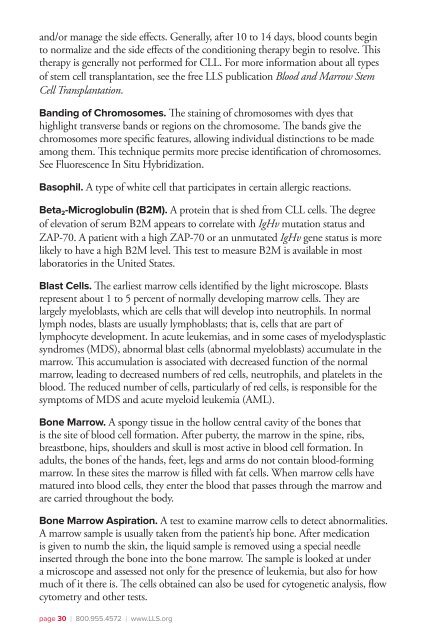Chronic Lymphocytic Leukemia - The Leukemia & Lymphoma Society
Chronic Lymphocytic Leukemia - The Leukemia & Lymphoma Society
Chronic Lymphocytic Leukemia - The Leukemia & Lymphoma Society
Create successful ePaper yourself
Turn your PDF publications into a flip-book with our unique Google optimized e-Paper software.
and/or manage the side effects. Generally, after 10 to 14 days, blood counts begin<br />
to normalize and the side effects of the conditioning therapy begin to resolve. This<br />
therapy is generally not performed for CLL. For more information about all types<br />
of stem cell transplantation, see the free LLS publication Blood and Marrow Stem<br />
Cell Transplantation.<br />
Banding of Chromosomes. <strong>The</strong> staining of chromosomes with dyes that<br />
highlight transverse bands or regions on the chromosome. <strong>The</strong> bands give the<br />
chromosomes more specific features, allowing individual distinctions to be made<br />
among them. This technique permits more precise identification of chromosomes.<br />
See Fluorescence In Situ Hybridization.<br />
Basophil. A type of white cell that participates in certain allergic reactions.<br />
Beta 2-Microglobulin (B2M). A protein that is shed from CLL cells. <strong>The</strong> degree<br />
of elevation of serum B2M appears to correlate with IgHv mutation status and<br />
ZAP-70. A patient with a high ZAP-70 or an unmutated IgHv gene status is more<br />
likely to have a high B2M level. This test to measure B2M is available in most<br />
laboratories in the United States.<br />
Blast Cells. <strong>The</strong> earliest marrow cells identified by the light microscope. Blasts<br />
represent about 1 to 5 percent of normally developing marrow cells. <strong>The</strong>y are<br />
largely myeloblasts, which are cells that will develop into neutrophils. In normal<br />
lymph nodes, blasts are usually lymphoblasts; that is, cells that are part of<br />
lymphocyte development. In acute leukemias, and in some cases of myelodysplastic<br />
syndromes (MDS), abnormal blast cells (abnormal myeloblasts) accumulate in the<br />
marrow. This accumulation is associated with decreased function of the normal<br />
marrow, leading to decreased numbers of red cells, neutrophils, and platelets in the<br />
blood. <strong>The</strong> reduced number of cells, particularly of red cells, is responsible for the<br />
symptoms of MDS and acute myeloid leukemia (AML).<br />
Bone Marrow. A spongy tissue in the hollow central cavity of the bones that<br />
is the site of blood cell formation. After puberty, the marrow in the spine, ribs,<br />
breastbone, hips, shoulders and skull is most active in blood cell formation. In<br />
adults, the bones of the hands, feet, legs and arms do not contain blood-forming<br />
marrow. In these sites the marrow is filled with fat cells. When marrow cells have<br />
matured into blood cells, they enter the blood that passes through the marrow and<br />
are carried throughout the body.<br />
Bone Marrow Aspiration. A test to examine marrow cells to detect abnormalities.<br />
A marrow sample is usually taken from the patient’s hip bone. After medication<br />
is given to numb the skin, the liquid sample is removed using a special needle<br />
inserted through the bone into the bone marrow. <strong>The</strong> sample is looked at under<br />
a microscope and assessed not only for the presence of leukemia, but also for how<br />
much of it there is. <strong>The</strong> cells obtained can also be used for cytogenetic analysis, flow<br />
cytometry and other tests.<br />
page 30 I 800.955.4572 I www.LLS.org

















